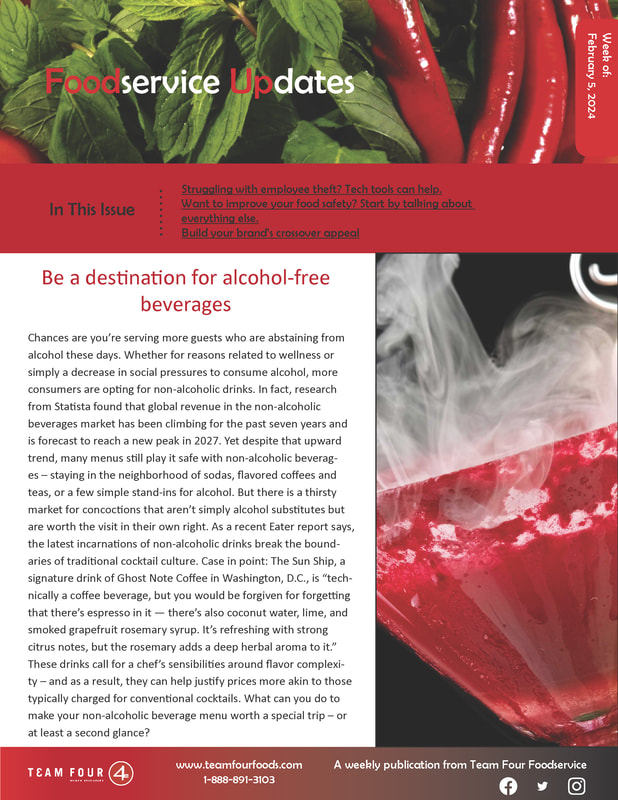 Food allergies affect nearly 11 percent of adults and 8 percent of children, sending 200,000 people to the hospital in the U.S. each year. As a result, chances are good that every day, you’re having to respond to guest questions and concerns about allergens in your menu items. Being able to do this during busy shifts, smoothly and without creating bottlenecks, requires tools that allow your staff to have access to allergen information at their fingertips so they can steer guests toward foods that are safer for them. As a recent report from Modern Restaurant Management explains, restaurants can accomplish this with an up-to-date POS that is connected with their kitchen and can show real-time information about food allergens based on the menu items being offered in that moment. Combine this with payment technologies that allow the guest to input information about their allergies up front, thereby immediately omitting any menu items that could be problematic for them, and restaurants can significantly reduce their potential “points of failure” around food allergies. Doing so isn’t just the right thing to do – it’s also good for business, considering that food allergy sufferers are a loyal group. When you can provide a meal that is safe and enjoyable for a guest, they are apt to favor your restaurant in the future and recommend it to others who struggle with allergies as well.  If a guest asks a question about the potential for an allergen in a dish, how confident are you in the response your employees are likely to provide? If a guest experiences an allergic reaction while in your restaurant, how confident are you that your staff can respond with speed, efficiency and sensitivity? Chick-fil-A is one restaurant brand that has earned accolades for its handling of such questions. In a recent webinar from Food Safety Magazine, Steven Lyon, Ph. D, the brand’s director of food safety – field operations, shared some information about how Chick-fil-A manages communication around allergens, as well as its response to guest concerns and allergen reactions. The brand uses a number of safety nets to support staff. For example, while servers should be able to describe dishes, tell guests how an item is prepared, and suggest items that don’t contain the allergen in question, Chick-fil-A employees can help guests make a more informed decision about a dish by hitting a button on the POS system to generate a list of allergens in a food. The kitchen helps ensure cross-contamination doesn’t happen by using separate cooking oils and fryers for allergens, clearly identifying allergens on an order, confirming the order with staff, and delivering the order to the guest to ensure there is no cross-contamination from plate to plate. Beyond the cooking process, they label food packaged onsite, work with suppliers to understand the potential for allergens to be introduced during food production, and use a system that sends its stores recall updates in real time. If a guest has a reaction, Lyon recommends having a minimum response plan. For example, that may include knowing to call 911, what details to provide an emergency responder, and how to take care of a guest waiting for help – information that may or may not be common knowledge among your staff.  In a recent webinar from Food Safety Magazine, Hal King of Active Food Safety explained how pervasive food allergies are among consumers and also identified some allergy-related vulnerabilities foodservice businesses may have. Specifically, he said food allergies affect about 15 million people and cause 30,000 visits to the emergency room. What’s more, a study conducted over a 13-year period found that half of the deaths that link back to food allergies were caused by a restaurant or other foodservice establishment. Here’s where foodservice businesses can help minimize those figures: The two primary controls that restaurants can use to avoid triggering a food allergy are avoidance messaging for the guest (on menus and other signage where food options are displayed and ordered) and prevention (by being attuned to allergens potentially being introduced by suppliers or during food preparation). King noted that one area where many restaurants fall short is on digital menus, which he said rarely include avoidance messaging to alert people to allergens and/or to the likelihood that the kitchen won’t be able to guarantee the absence of an allergen. How well do your digital menus – on your website, app, social media and elsewhere – promote allergen awareness across your brand?  Considering that an estimated 33 million Americans have food allergies – including one in 13 children under age 18 – it would be understandable for a restaurant to shy away from serving allergic guests. But there are some restaurant operators doing the opposite and seeing real opportunity in being a trusted source of food. Dominic Jones, CEO of JPRestaurants, is among them – and it started when his child was diagnosed with a peanut allergy, according to a recent article from New Food Magazine. In the years since, his restaurant has shifted from warning allergy sufferers to welcoming them, increased the transparency of their supply chain, developed a dedicated allergy menu that eliminates the major allergens, and launched ongoing efforts to make their supply chain, recipes and front- and back-of-house processes safer for guests with allergies. (They share these efforts in a Food Allergy Approach page on their restaurant’s website.) Jones says these actions have generated revenue growth and increased guest loyalty, in addition to improving their food quality overall.  You may have separate preparation areas and tools for foods containing allergens, a staff that can name the big eight allergens that trigger the most problems for people, and clear warnings on your menu encouraging guests to alert staff about allergens. But you can still slip up with an allergic guest if communication from the guest to the server to the kitchen and back isn’t clear. In fact, this triggered a severe allergy for a 12-year-old boy in Massachusetts several years ago. Due to a misunderstanding by restaurant staff, the boy was served a pastry filled with peanut butter despite having told the server of his peanut allergy. The boy’s mother had an EpiPen on hand – otherwise the allergy could have been fatal. Now, the family is working to advance legislation that would update food allergy training materials and require restaurants in the state to always be staffed with someone who has used the updated materials. What safety mechanisms do you have in place – tech-based or not – to make sure your staff communicates clearly with guests and each other about allergies?  Gluten can be a tricky allergen. Even products labeled as gluten-free, as well as seemingly safe products like meat, may contain trace amounts of the protein. About 7 percent of the U.S. population are either gluten-sensitive or have celiac disease (and rates of celiac disease are rising by 7.5 percent annually). These people may experience abdominal pain, chronic fatigue or diarrhea when they eat gluten. There is gluten-sensing technology in development that aims to make it easier to detect trace amounts of gluten in foods, but in the meantime, restaurants’ efforts to accommodate gluten-sensitive guests can go far in earning their loyalty. A recent report from Food Management advises you have a checklist of regularly ordered foods and identify gluten-free items on the list, establish with vendors that you are committed to having gluten-free substitutes available, have a clear system to identify gluten-free items on your menu, and consider having your business validated by the Gluten-Free Food Service, which supports organizations looking to implement gluten-free safety procedures for the long term.  Consumers with food allergies are a growing – and potentially loyal – group of guests. But as a recent QSR Magazine report indicates, a large percentage of restaurant staff aren’t equipped to identify and serve allergens safely. As this study found, more than 70 percent of restaurant staff believe the food they serve is safe but less than half of these employees had received allergen-specific training. At a time when the FDA’s list of major allergens continues to expand with the addition of sesame this year, are your staff aware of new labeling requirements and how to handle allergens safely?  Cold winter nights are just right for restaurant delivery. How confident are you in the food safety commitment of those bringing food to your guests? Whether they are third-party vendors or your own staff, their approach to transporting food can impact everything from the temperature at which an order is received, to whether the food of an allergic guest is safely kept separate from other items. Any new packaging you have introduced in recent months can call for additional adjustments in how orders are handled. What mechanisms do you have in place to assess your delivery safety risks so you can make adjustments as needed?  In 2023, the FDA began recognizing sesame as an official allergen, triggering a response in some restaurants that has surprised some consumers. As a recent report from Fast Company indicates, sesame seeds are so prone to cross-contamination due to their small size that it’s challenging for restaurants and food producers alike to guarantee their absence from foods. So instead, sesame is being added to recipes where, in many cases, it wasn’t present before, in order to provide greater clarity to consumers about the presence of the allergen. This leaves allergic guests – who can be especially loyal to restaurants that support them – with fewer options and at potentially greater risk for consuming a cross-contaminated food. If you’re looking for ways to abide by the new rules while offering options to allergic guests, the group Food Allergy Research & Education may be of help.  Beginning this month, sesame legally became the ninth major food allergen that requires clear labeling if it is an ingredient in a food product. According to Food Safety Magazine, cross-contamination and mislabeling of food have caused allergens to be the most frequent reason for food recalls each year. It’s a good time to give your team a refresher on overall allergen awareness and the steps needed to document training and prevent cross-contamination in your operation. |
subscribe to our newsletterArchives
July 2024
Categories
All
|



 RSS Feed
RSS Feed